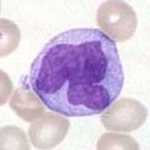Monocyte

|
WikiDoc Resources for Monocyte |
|
Articles |
|---|
|
Most recent articles on Monocyte |
|
Media |
|
Evidence Based Medicine |
|
Clinical Trials |
|
Ongoing Trials on Monocyte at Clinical Trials.gov Clinical Trials on Monocyte at Google
|
|
Guidelines / Policies / Govt |
|
US National Guidelines Clearinghouse on Monocyte
|
|
Books |
|
News |
|
Commentary |
|
Definitions |
|
Patient Resources / Community |
|
Directions to Hospitals Treating Monocyte Risk calculators and risk factors for Monocyte
|
|
Healthcare Provider Resources |
|
Causes & Risk Factors for Monocyte |
|
Continuing Medical Education (CME) |
|
International |
|
|
|
Business |
|
Experimental / Informatics |
Editor-In-Chief: C. Michael Gibson, M.S., M.D. [1]
Synonyms and keywords: mononuclear cell, monocyte
Overview
A monocyte is a leukocyte, part of the human body's immune system that protects against blood-borne pathogens and moves quickly (aprox. 8-12 hours) to sites of infection in the tissues. Monocytes are usually identified in stained smears by their large bilobate nucleus.
Physiology
Monocytes are produced by the bone marrow from haematopoietic stem cell precursors called monoblasts. Monocytes circulate in the bloodstream for about one to three days and then typically move into tissues throughout the body. They constitute between three to eight percent of the leukocytes in the blood. In the tissues monocytes mature into different types of macrophages at different anatomical locations.
Monocytes are responsible for phagocytosis (ingestion) of foreign substances in the body. Monocytes can perform phagocytosis using intermediary (opsonising) proteins such as antibodies or complement that coat the pathogen, as well as by binding to the microbe directly via pattern-recognition receptors that recognize pathogens. Monocytes are also capable of killing infected host cells via antibody, termed antibody-mediated cellular cytotoxicity. Vacuolization may be present in a cell that has recently phagocytized foreign matter.
Monocytes which migrate from the bloodstream to other tissues are called macrophages. Macrophages are responsible for protecting tissues from foreign substances but are also suspected to be the predominant cells involved in triggering atherosclerosis. They are cells that possess a large smooth nucleus, a large area of cytoplasm and many internal vesicles for processing foreign material.

Diagnostic use
A monocyte count is part of a complete blood count and is expressed either as a ratio of monocytes to the total number of white blood cells counted, or by absolute numbers. Both may be useful in determining or refuting a possible diagnosis. Monocytosis is the state of excess monocytes in the peripheral blood. It may be indicative of various disease states.
Examples of processes that can increase a monocyte count include:
- chronic inflammation
- stress response
- hyperadrenocorticism
- immune-mediated disease
- pyogranulomatous disease
- necrosis
- red cell regeneration

Dendritic cells
Monocytes can be used to generate dendritic cells in vitro.
See also
External links
- Histology image: 01702ooa – Histology Learning System at Boston University
- Human Monocytes - Prof. Dr. Ziegler-Heitbrock
bs:Monociti cs:Monocyt de:Monozyt eo:Monocito it:Monocita he:מונוציט lt:Monocitas nl:Monocyt sk:Monocyt sr:Моноцити sv:Monocyt